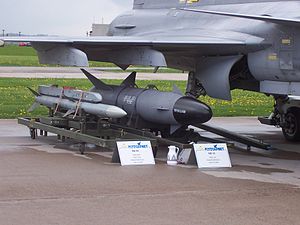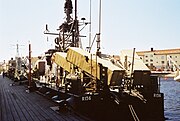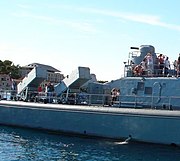| RBS-15 | |
|---|---|
 RBS-15 on right | |
| Type |
Fire-and-forget anti-ship and land attack |
| Place of origin | Sweden |
| Service history | |
| In service | 1985- present |
| Used by | See operators |
| Production history | |
| Manufacturer | Saab Bofors Dynamics, Diehl BGT Defence |
| Specifications | |
| Mass | 800 kg |
| Length | 4.33 m |
| Diameter | 50 cm |
| Warhead | 200 kg HE blast and pre-fragmented |
Detonation mechanism | impact or proximity |
|
| |
| Engine | turbojet |
| Wingspan | 1.4 m |
Operational range | 250 km |
| Flight altitude | sea skimming |
| Maximum speed | subsonic |
Guidance system | inertial, GPS, active radar (J band) |
Launch platform | naval ships, aircraft and land-based missile launchers |
The RBS-15 (Robotsystem 15) is a long-range fire-and-forget surface-to-surface and air-to-surface, anti-ship missile. The later version Mk. III has the ability to attack land targets as well. The missile was developed by the Swedish company Saab Bofors Dynamics.
History[]
The Swedish Navy was pioneering anti-ship missiles with the Halland Class of destroyers using the RB08 missile since the early 1960s. Owing to the Defence decision of 1958 the main effect for the navy was a restructuring into a lighter force consisting of FAC vessels and a halt to destroyer procurement. This posed a problem as the existing RB08 missile required launch rails and a missile magazine in the destroyers, taking up space that was simply not there on smaller ships. Adding to the problems, each missile had to be individually prepared for launch and only two missiles could be on the launch rails at the same time. In comparison, the STYX missile used by the Soviet Union (which was the expected adversary) stored the missiles in individual containers on deck which left the missiles immediately available for launch. Tests were carried out on Plejad class FACs with a single bow mounted RB08 in the late 1960s, but these tests came to nothing.

HMS Småland, radar and two RB 08 Missiles
Next attempt by SAAB to take an order for anti-ship missiles to equip the Norrköping class FACs of the Swedish navy was first presented in 1978 as under the project name "RB 04 Turbo" a development of the air force RB 04E missile with a turbofan engine changed wing configurations and start rockets to take off from land. The initial proposal was rejected as inferior to the Harpoon. The project under the leadership of Hans Ahlinder then worked out a proposal for a missile with greater capabilities and superior performance to the Harpoon. As a way to indicate that it was a new weapon the project name was changed from "RB 04 Turbo" to "RBS-15"[1]

RB04 Missile
The first weapon contract was signed in 1979, at the last minute the Swedish government had opted not to buy the Harpoon anti-ship missile and opting for an indigenous design. The first missiles were delivered to the Navy in June 1984, and the ship version RBS-15 Mk. I was introduced.

RBS-15 Mk 1 on Swedish Missile Boat HMS Västervik
The missile had been ordered in 1984 by the Swedish Navy to develop a coastal defense version of the RBS-15F. The missile was taken into Swedish Navy service as the Rb 15 by the Swedish Navy and became operational in 1985. The Swedish Air Force received their missiles a couple of years later. The Mk. I was produced from 1985 to 1990.
Work on a further developed version, the RBS-15 Mk. II, was initiated in the early 1980s. But it took until 1994, before a development contract was signed for the upgraded anti-ship missile. The Mk. II has the same range (70+ km), but the mid-course and terminal guidance system, as well as the radar and IR signature were upgraded. The Mk. II has been produced since 1998.
The development of the RBS-15 Mk. III began in the mid-1990s. Emphasis was put on increased range (due to larger fuel capacity and new fuel the range has been increased to some 200 km), improved accuracy (integrated GPS) and selectable priority targeting, which improved the weapon system's flexibility. The Mk. III missile will also be produced by Diehl BGT Defence of Germany for the new class of German stealth corvettes, and is likely to be later used on other German Navy vessels as well. Finnish truck maker Sisu produces missile launch trucks for RBS-15. The Mk. III has been in production since 2004.
Development phase[]
The missile was developed from the RB 04 missile that was used by the Swedish air force. The front of the missile was retained, including the warhead, but the rear received new wings and a turbofan engine replaced the rocket previously used. The RBS-15 underwent trials on the missile FAC HMS Piteå from 1983 and became operational with the Swedish Navy in 1985. The Västergötland class submarines were projected to have 4 vertical missile launch tubes for RBS-15 missiles in an extended hull but this was canceled due to budget constraints and it didn't fit the way Swedish submarines operated.
Versions[]
- RBS-15 Mk. I
- Powered by a French Microturbo TRI-60 engine, with a thrust of 3.73 kN (380 khp/830 lbf). Range 70+ km
- RBS-15F
- An Mk. I adapted for air launch. Entered service in 1989.
- RBS-15 Mk. II
- Range 70+ km. Designed to be launched from a number of different platforms, such as land-based launchers, aircraft, and ships.
- RBS-15SF
- Mk. II version for Finland. Local designation MTO 85 (Meritorjuntaohjus 1985)
- RBS-15 Mk. III
- [2] Range 200 km, with land attack capability. There is only a ship launched version. Production started in 2004. New Oval launch tubes instead of the old box type.
- RBS-15SF-3
- Both new Mk. IIIs and upgraded Mk. IIs, which have been upgraded to Mk. III standard. Finnish designation MTO 85M
- RBS-15 Mk. IV
- Currently being developed. Incorporates dual seekers, has a longer range and new missile link system. The radar signature has been reduced and its warhead can be changed depending on the mission. Future upgrades may include concept optimization for sea or land targets. The range of the Mk. IV would have to be significantly larger than others versions, over 1 000 km.
Operators[]
Current operators[]

Croatian MOL with RBS-15 missiles

Croatian missile boat Kralj Dmitar Zvonimir with RBS-15 missiles
RBS-15 Mk. III will equip the two MEKO 200 frigates under construction for the Algerian National Navy. Delivery is scheduled for 2015-2016.[3][4][5]
 Croatia
Croatia- It is the primary weapon of the Croatian Navy for its five guided missile corvettes and three coastal systems mounted on Tatra trucks. In total, 48 Mk.I units are in service but the servicebility of all missiles is questionable seen as only 28-30 are operational as of 2010. Plans for upgrading 21 missiles to the Mk.III standard was cancelled in 2009 due to budget restraints but light software upgrades are continuously executed and improve the missiles' navigation, precision and electronic defence. The latest of this upgrades was conducted in 2010 as a part of usual service works.
 Finland
Finland- The Finnish Navy operates both RBS-15SF (Mk. IIs, designation MTO 85, 70 units) and RBS-15SF-3 (Mk. III, designation MTO85M, 48 units). The Mk. IIs are operated from Rauma class FACs (previously on Helsinki class vessels as well), and it is also mounted on Sisu trucks for mobile coastal defense. The Mk. IIIs are operated from Hamina class FACs. Older Mk. IIs (RBS-15F) have been upgraded to Mk. III standard (RBS-15K).
 Germany
Germany- The German Navy has chosen the Mk. IIIs and Mk. IVs to equip its Braunschweig class corvettes and planned F125-class frigates and also plans to upgrade its Brandenburg-class frigates with Mk. III
 Poland
Poland- The Polish Navy has chosen the Mk. III to equip its Orkan class missile. A deal worth 110 million € was signed and the Orkan class ships modifications will be carried out by Thales Naval Netherlands. Mk.II missiles for Navy mobile land based launchers have also been delivered as part of the offset deal.
 Sweden
Sweden- The Swedish Navy operates the missiles from its Stockholm, Göteborg and Visby class corvettes. The Swedish coastal artillery was also equipped with RBS-15Ms, which were mounted on Volvo trucks. The Swedish Air Force operates the RBS-15F. The AJS 37 Viggen and the JAS 39 Gripen carries the missile, with the Viggen no longer in service . The following missiles are or have been used by the different branches: RB04E, RB08A, RBS08A, Mk. I, Mk. II Mk. III, RBS-15F ), RBS-15K and RBS-15M.
 Thailand
Thailand
As a part of its Gripen procurement program, the Royal Thai Air Force will order the air-launch version, the RBS-15F, to equip its Gripen fighter aircraft in an agreement between Sweden and Thailand.[6]
Former operators[]
 Yugoslavia
Yugoslavia- Some RBS-15s were delivered during the late 80's for implementation on the new Yugoslavian Navy FACs to replace existing Russian-built missiles, but this project was never finalized due to the Yugoslav wars. Missiles have since ended up in the Croatian navy.
See also[]
References[]
- ↑ [1] "Arboga Missile Museum" on how the RB 04 Turbo became RBS-15 - Swedish Text
- ↑ "RBS15 Mk3 Surface-to-Surface Missile (SSM)". Naval Technology. 2011-06-15. http://www.naval-technology.com/projects/rbs15-mk3-surface-to-surface-missile-ssm/. Retrieved 2013-10-10.
- ↑ "Algerian Navy signs deal with ThyssenKrupp Marine Systems for 2+2 Meko A200 Frigates: Details". Navyrecognition.com. 2012-07-25. http://www.navyrecognition.com/index.php?option=com_content&task=view&id=525. Retrieved 2013-09-02.
- ↑ "Algerian Navy ships and equipment". Navyrecognition.com. 2012-07-25. http://www.navyrecognition.com/index.php/world-naval-forces/african-navies-vessels-ships-equipment/algeria-algerian-navy-vessels-ships-equipment.html. Retrieved 2013-10-10.
- ↑ http://www.seanews.com.tr/article/worldship/76252/Algeria-ThyssenKrupp-Marine-SystemsKrupp-/
- ↑ "FMV - FMV deliver three Gripen aircraft to Thailand". Fmv.se. http://www.fmv.se/en/News-and-media/In-focus/FMV-deliver-three-Gripen-aircraft-to-Thailand/. Retrieved 2013-10-10.
External links[]
- RBS15 Mk3 Surface-to-Surface Missile (SSM), Sweden
- Manufacturer's page
- GlobalSecurity.org
- German manufacturer's page (site in English)
- YouTube videoclip of land-based RBS 15
- Flight Global archive, 1973 issue on Anti Ship Missiles
| Wikimedia Commons has media related to RBS-15 missiles. |
The original article can be found at RBS-15 and the edit history here.